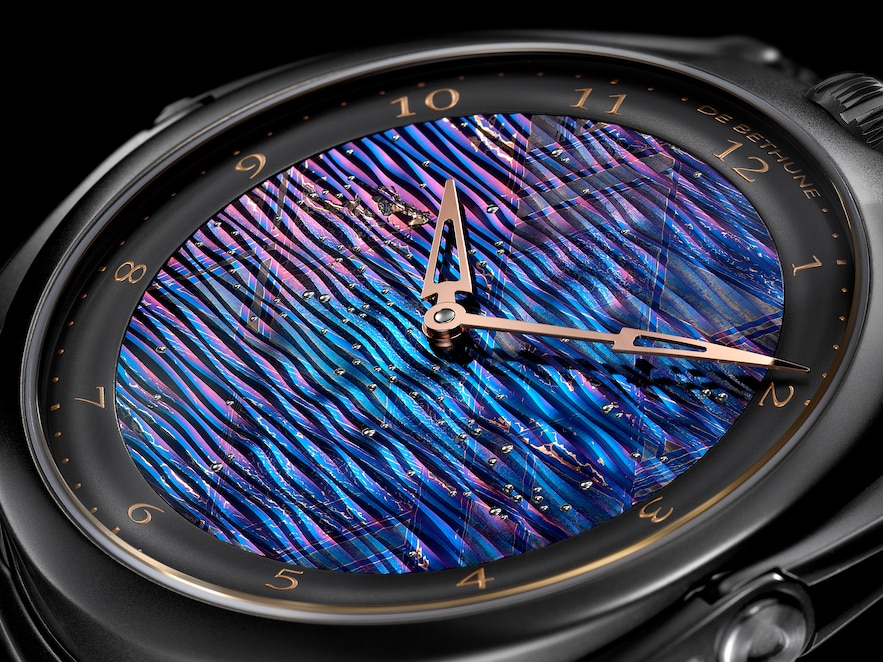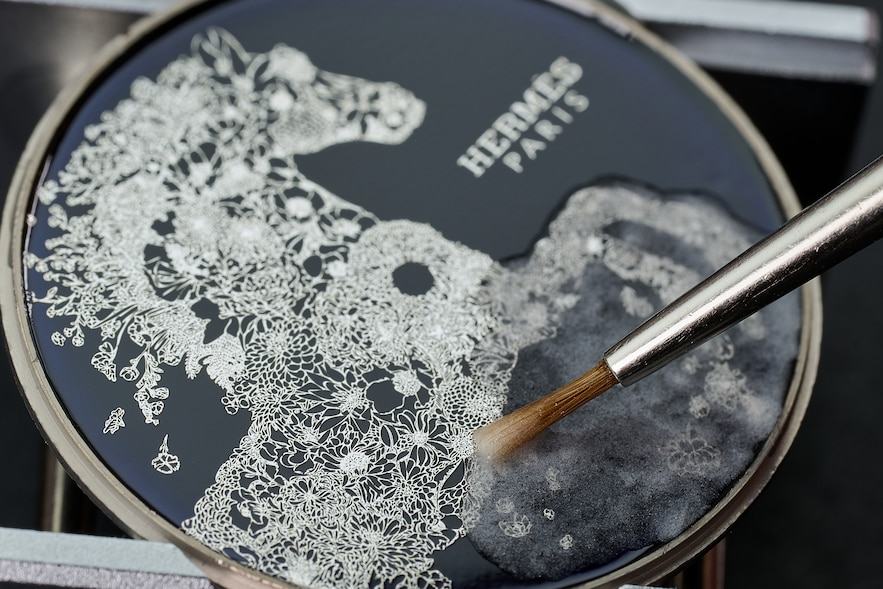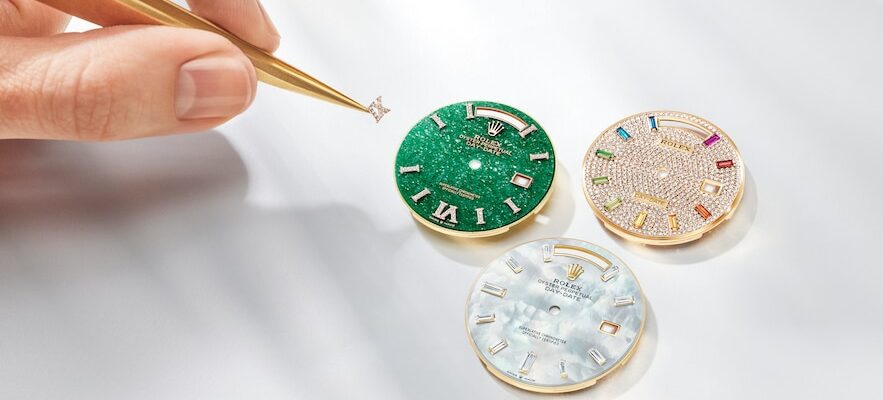At the intersection between traditional watchmaking know-how and modern technologies, the creation of a dial requires several dozen operations whose purpose is to decorate this metal disc, or even to transfigure it into a miniature work of art. The profession of dial maker, which is used by manufacturers, requires mastering multiple techniques: mechanics, of course, but also electroplating (use of electroplating to cover an object with a thin layer of metal), setting ( for fixing precious stones) or enamelling.
Ornamental aventurine stone dial on the Oyster Perpetual Day-Date 36, full set dial on the Oyster Perpetual Day-Date 36, Mother-of-pearl dial on the Oyster Perpetual Day-Date 36
© / Ulysse Fréchelin/Rolex
Rolex, for example, uses a wide range of more or less traditional finishes. For a sunburst dial, two brushes sweep and create tiny streaks that run from the center to the outside of the surface. The satin finish, carried out by sandblasting, allows you to obtain a uniformly matte surface. Watch decorations can be made by mechanical guilloché (intaglio engraving by removal of material) or by grand feu enamelling, using the champlevé technique, which consists of removing a little metal to embed enamel. Other methods use laser. As for the coloring of the dials, it is obtained using three techniques: lacquering for intense colors, electroplating adapted to metallic colors and PVD treatment, or physical vapor deposition. This technology consists of modifying the molecular properties of the surface of a metal by depositing thin layers of materials. A coating that gives free rein to the expression of numerous colored nuances.
The limits of creativity are pushed back when science combines with natural elements. The DB28xs Aérolite (De Bethune) features a dial with a unique random guilloché pattern that evokes the undulating surface of a starry sea. This timepiece is inspired by the Japanese concept of wabi-sabi, which celebrates beauty in imperfection. The deep blue of the dial, obtained by thermal oxidation, is studded with delicate shards of white gold. The whole contrasts with the geometric lines of a piece of the Muonionalusta meteorite, one of the oldest known on Earth.

The DB28xs Aérolite (De Bethune) features a dial with a unique random guilloché pattern that evokes the undulating surface of a starry sea. This timepiece is inspired by the Japanese concept of wabi-sabi, which celebrates beauty in imperfection.
© / De Bethune
Iridescence Quest
Also influenced by nature, the young brand ID Genève unveiled its second Elements collection in September, which is distinguished by five dials at the frontiers of sensory design. Several layers of decals are applied to these dials which play with contrasts, taking inspiration from the blues of the Morpho butterfly’s wings, beetle elytra, pearly reflections of shells or the shimmering plumage of certain birds to create visual effects.
The dial of the iridescent BRX5 from Bell & Ross is made of several thin layers of PVD, one on top of the other, with differences in spraying.
Iridescence is the property of certain surfaces which appear to change color depending on the angle of view or illumination. These colors are not due to pigments but to optical phenomena, visible on a soap bubble or on the wings of a beetle. By crossing the complex stack of microstructures created by the different layers of PVD, the light rays interfere. The tones that we then observe range from green to blue and even purple, even including orange when the room is tilted. Bell & Ross applied this PVD coating to a sunburst surface to add even more movement to this structural effect.
The quest for iridescence also guided the collaboration between the Argentine artist Felipe Pantone and the Zenith manufacture. In the case of the Defy Skyline Tourbillon, a micro-engraving of concentric circles on a sapphire disc reproduces the moiré effect omnipresent in Pantone’s work. On the reverse side of the dial a reflective metallic layer has been applied which, combined with micro-engraving, produces a striking play of colors, like a CD.
The Biver Time for Art model was also designed in association with an artist. The unique piece created will be offered for auction on December 7 in New York as part of the TimeForArt charity sale. Inspired by the paintings of Guillaume Ehinger, the white gold plate of the dial is hand-engraved with an undulating pattern before being covered with several layers of colored enamel. The resulting shimmering surface, in red and pink tones, evokes the appearance of a lake at sunset.
Imagined as a variation of works of art, the new Awake collection ventures into territory that the young French brand had never explored before. Its founder, Lilian Thibault, chose to combine in a unique way in watchmaking two artistic professions that he discovered during a trip to Vietnam: Son Mai – Vietnamese sanded lacquer – and silver leaf gilding .
The ancestral art of Son Mai consists of superimposing and polishing layers of natural lacquer to obtain a lustrous surface. Tradition dictates that artisans incorporate other materials such as crushed eggshells, gold leaf, or mother-of-pearl to add texture and depth. Awake opted for the integration of pure silver leaves: a complex and delicate method for a striking visual effect. To which is added a luminous signature at nightfall: the indexes and hands are wrapped in Super-LumiNova® and create a play of chiaroscuro. Their design generates backlighting effects to magnify the depth and reflections of the lacquer. In total, each dial will have required between ten and fifteen hours of manual labor, while the entire process can take several weeks.
Varied and unique patterns
Another Asian inspiration at Citizen, this time from the Land of the Rising Sun, where the brand was born. After celebrating the 100th anniversary of its first watch – notably in Paris where a retrospective of the Japanese company’s innovations was presented – a limited edition of The Citizen models, the high-end collection, was unveiled. On the dial, washi paper dyed with indigo. Also known as “Japanese blue”, indigo is one of the oldest natural plant-based dyes in the art of dyeing. The dial is created using a traditional Japanese decorative technique called “shibori”, which involves folding, twisting and binding fabrics before dyeing them, creating varied and unique designs.

The Hermès Watch. Making of Shooting Arceau light dress at Atelier Olivier Vaucher. Le Petit-Saconnex Geneva, 08.27.2024 Photo David Marchon
© / David Marchon
For fine watchmaking pieces, the houses regularly rely on artistic crafts in all their diversity. Thus, the model that Chopard is dedicating to the TimeForArt charity sale benefits from straw marquetry. It was made by an artisan decorator from the factory specially trained in this 17th century technique. While the reference Arceau Light dress signed Hermès highlights paillonné enamel, which consists of inserting silver spangles between the layers and reliefs. The enameled base, dark in color, is first applied with a brush. The patterns, shaped in silver leaf, are then placed there. These tiny straws are finally frozen through successive cooking.
For its part, Vacheron Constantin pays homage to Chinese culture via four Métiers d’Art limited editions which represent a cliff bathed in the waves, a decorative symbol specific to the imperial court of the Ming and Qing dynasties. On the same dial, grand feu enamel, setting and engraving with champlevé enamel inlays are combined. So many operations that require reconciling technical expertise and aesthetic sensitivity.
